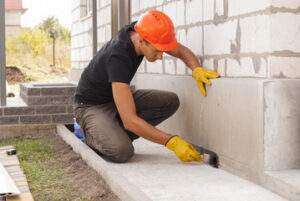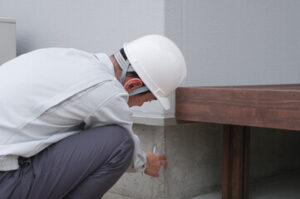Homeowners can reduce the need for costly repairs by regularly inspecting their homes. Addressing plumbing leaks promptly and landscaping properly can also prevent problems.

Expansive clay soils can exacerbate foundation issues by pushing up a home during wet seasons and sinking it down during dry ones. A foundation contractor may recommend a support system like piers or slab jacking (also known as mud jacking). Contact Pros Foundation Repair Greensboro NC for professional help.
Small cracks in a foundation can be normal and harmless, but larger ones can be a serious warning signal. These gaps can be pathways for water infiltration, resulting in significant structural damage to the house and potential health risks to its inhabitants. It is vital to take the time to inspect and monitor these spaces, catching them early on when they are still minor issues.
The most common types of cracks in a foundation are hairline, or less than the thickness of a penny. These are usually caused by expansion and contraction of the concrete as temperatures rise and fall. This type of cracking is typically not a cause for concern, and will probably be fixed by itself in time. However, homeowners should be sure to watch these cracks for growth and call a professional if they do grow or continue to expand.
More serious cracks are those that have a jagged diagonal pattern or extend beyond a wall’s width. These are a sign that the structure is shifting or that pressure is being exerted on the foundation from outside. This could be due to soil movement, poor drainage, frost heave, hydrostatic pressure, construction flaws, or tree root growth. Any crack accompanied by a damp basement, sticking doors or windows, or uneven floors is a serious problem and should be addressed immediately to prevent further damage.
To reduce the risk of these types of cracks, be sure to monitor exterior soil erosion and keep trees and shrubs trimmed away from your home’s foundation. You should also be mindful of where rain gutter downspouts lead, ensuring they are directing water at least 10 feet from your foundation. Proper site preparation during construction and installation of quality materials are also important steps in reducing the risk of future problems. When these problems are spotted, there are many ways to fix them. These options include interior and exterior basement waterproofing, using epoxy or polyurethane injection to seal cracks, carbon fiber straps bonded with epoxy to reinforce walls, and installing wall anchors or helical tiebacks to straighten bowing or tilting foundation walls.
Structural Issues
If you notice horizontal cracks that run across ceilings and walls, or doors and windows that won’t open or close properly, these are warning signs of structural issues in your foundation. These are often caused by natural processes like ground shifting and soil movement, or poor construction or drainage. If left unchecked, these issues can worsen over time and lead to serious damage. Early detection and efficient solutions can prevent these problems from escalating into costly structural repairs.
A common cause of structural issues is the build-up of hydrostatic pressure on your foundation. This happens when water from the surrounding soil seeps into the structure and builds up against the bottom of your foundation. This can cause heaving and sinking, which can affect the entire building’s stability.
To prevent hydrostatic pressure from building up against your foundation, you can install drains around the home and extend downspouts so water flows away from the property. You can also prevent this issue by maintaining the slope of the soil around your home. If it slopes towards your foundation, this can cause water to pool near the foundation and create hydrostatic pressure.
You can also keep an eye out for any changes in your home’s structure and take action as soon as possible if you spot these issues. If you notice that your walls are cracking, or doors and windows are sticking, these are warning signs of foundation problems that need to be addressed immediately. This will help you avoid further damage to your home and ensure that it’s safe to live in.
Professionals will conduct a thorough assessment of the condition of your foundation and identify its root causes, which may include soil settlement, faulty construction, water damage, or other factors. This information will guide the repair strategy, ensuring that the most effective and efficient solution is implemented. This could involve filling in cracks, using piers to stabilize the foundation, or other techniques. It’s important to choose an experienced, qualified contractor for these services so that you can be confident that the repairs will be done correctly and efficiently.
Insurance Coverage
Homeowners often wonder whether foundation damage is covered by their insurance. It depends on the cause of the damage, the specifics of the policy, and whether or not the homeowner takes steps to prevent future problems. In general, homeowner’s insurance typically only covers foundation damage caused by fire, windstorms, certain water damage, and some types of soil movement. The major exceptions are floods and earthquakes, which require separate policies. Foundation damage caused by wear and tear, gradual settling, poor maintenance, and neglect is usually considered the homeowner’s responsibility.
If your insurance company approves your claim, you will receive payment for the repairs. This could be a lump sum or several payments over time, depending on your policy details and repair timeline. If your claim is denied, it is important to understand why so you can take steps to prevent similar issues in the future.
In some cases, your insurance company may approve the repairs even if the damage is caused by a type of incident not listed in your policy. For example, sudden and accidental water damage caused by a burst pipe may be covered, as long as the damaged foundation is not due to a prolonged seepage of water or flooding.
When filing an insurance claim, the homeowner must provide evidence of the damage and its impact on the home. In some cases, a professional inspection is required to determine the extent of the damage and how extensive repairs will be. It is also important to keep detailed records of all work performed on your property.
Preventative maintenance and regular inspections by a licensed, reputable foundation contractor can help homeowners avoid costly foundation repairs in the future. Inspecting and addressing minor cracks, drainage problems, and tree root intrusions promptly can reduce the risk of further damage. By taking care of these minor issues before they escalate, homeowners can protect their biggest investment and ensure that their home functions as intended for many years to come.
If you are concerned about the state of your home’s foundation, contact Pinnacle for a FREE consultation. Our team can diagnose your problem and recommend the right course of action. We offer a wide range of repair services, including foundation waterproofing, concrete leveling, and more.
Warranty
Few aspects of a home are as important to its long-term security and functionality as the foundation. When issues with a home’s foundation arise, it can create structural problems that can affect everything from the doors and windows to the roof and plumbing. These issues rarely go away on their own, and the most serious problems can even lead to significant damage that requires extensive repair work. Fortunately, a strong foundation repair warranty from a reputable contractor can help ease these concerns.
Before selecting a contractor to perform a foundation crack repair, it is important to research their reputation through recommendations and online reviews. In addition, a contract should be provided that details the scope of the work, timelines, and cost estimates. This information will enable homeowners to make an informed decision about the best contractor for the job.
The cost of a foundation crack repair depends on the extent of the damage and the method used to fix it. Some methods require less invasive construction and are generally less expensive. Others use more invasive techniques and are more costly. Homeowners can reduce the cost of a foundation crack repair by negotiating with contractors and asking for discounts. It is also important to prioritize repairs based on the level of urgency.
In some cases, a foundation problem can be caused by weather conditions that exacerbate the issue. For example, excessive rain can saturate the soil, leading to expansion and increasing the pressure on a foundation. Similarly, prolonged droughts can cause the soil to dry out and shrink, which can also increase pressure on a foundation.
A reputable foundation repair contractor should offer a transferable warranty that will protect the investment made in the repairs for future owners. This provides peace of mind not only for the current homeowners, but also for potential buyers down the line. The warranty should provide a description of the warranty period, coverage details, and transferability, which can be helpful in making an informed decision.
